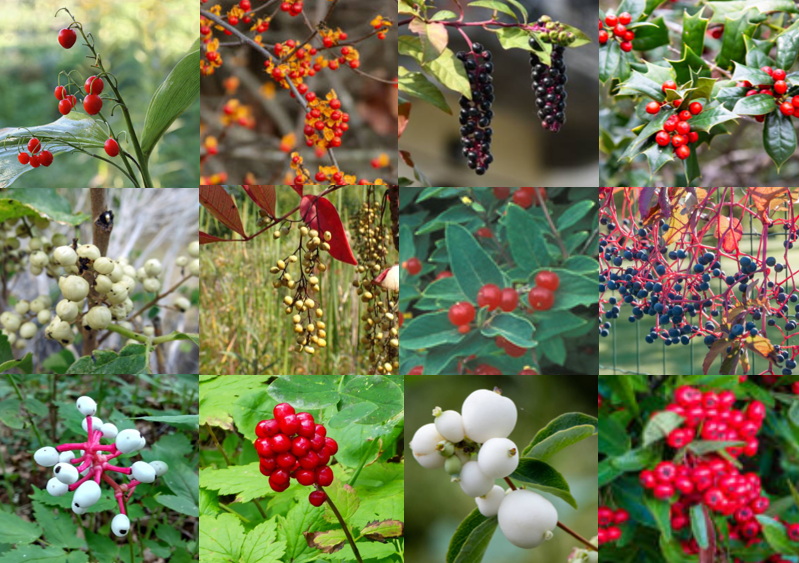Welcome to part 2 of our look at the berries you shouldn’t be foraging. This post features berries that will make you sick but are unlikely to prove fatal. Before we start, a reminder from the last post:
The best way to avoid eating poisonous species is to learn which of them grow in your area, and what edible berries you might mistake them for. A good resource, outside of an experienced forager, is Peterson’s A Field Guide to Venomous Animals and Poisonous Plants: North America North of Mexico.
A few quick general rules about foraging berries
If you’re unsure what it is, DO NOT EAT IT. Your life isn’t worth the gamble.
There are quite a few berries that grow in our area that are wildlife friendly but not people friendly – never assume that because the birds eat it you can too.
Plants that have spines, milky sap, or bitter smells rarely produce edible berries.
Yellow, green, and white berries should be left alone, as something like 90% of them are toxic.
Toxic – but Rarely Fatal – Berries Found in the Northeastern US

Lily of the Valley — All parts of the plant are poisonous, especially the red berries. A small amount can cause abdominal pain, vomiting, confusion, fatigue, and reduced heart rate.

Bittersweet vine, both the native variety and the more invasive Oriental species, can climb over 20 feet or sprawl as ground cover. It appears along roadsides, field edges, and disturbed spaces, preferring poor to average soil and partial to full sun. In the fall, yellow outer shells pop open to reveal bright orange-red seeds. All parts of the plant are toxic. Initial symptoms of poisoning include nausea, vomiting, and drowsiness. More serious signs include difficulty breathing, swelling, or seizures.
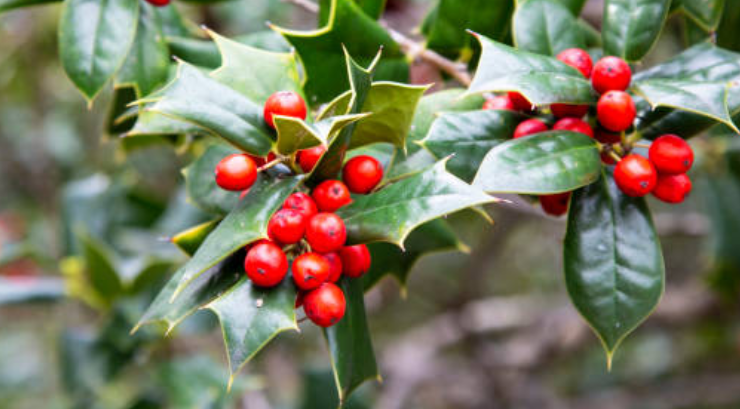
Holly berries are red, growing on small ornamental shrubs with shiny, spiky leaves, and are toxic for both humans and pets. They are not deadly, but can cause vomiting, diarrhea, dehydration, and drowsiness.

Mistletoe is generally found from New Jersey southwards. All parts of the plant, including its white berries, are toxic. If eaten, they are likely to cause severe stomach problems, and slow the heartbeat, with the potential to affect the brain, kidney, and adrenal glands.
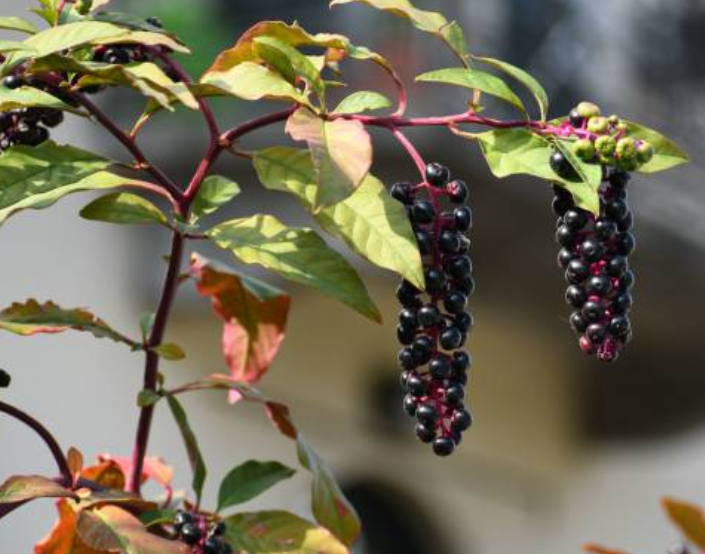
Pokeweed is a tall perennial weed with thick, reddish-purple branched stems and dark purple to black berries which hang in a drooping cluster. As it matures, it appears to become more poisonous. Eating the berries can cause nausea, vomiting, cramping, stomach pain, diarrhea, low blood pressure, incontinence, dehydration, and other adverse health effects.

Poison ivy can appear as either hairy climbing vines or small shrubs, with reddish stems and leaves in clusters of three. It can produce small, greenish flowers and green or off-white berries. The outer skin of the berry is lined and resembles the segments of a peeled orange. The toxin urushiol is found in these berries, and sensitivity to the poison varies with the individual. They can cause a rash, nausea, vomiting, and stomach cramps, while ingestion in large amounts can cause more serious effects.

Poison sumac is a deciduous tree or shrub with an open form. It typically reaches about 20’ in height. The compound leaves consist of 7–13 oval leaflets with smooth margins. Unlike the upright fuzzy reddish fruit clusters of true sumacs, poison sumac produces small, white, berry-like, waxy drupes that hang loosely from small stalks. When coming in contact with the plant, poison sumac often causes skin irritation, but the berries are particularly toxic because of their concentration of urushiol. Ingesting the berries causes nausea, vomiting, respiratory problems, and overall unease.

Tartarian honeysuckle is a mid-height shrub introduced as an ornamental that is now a noxious invasive, appearing in open fields and along roadsides. The bright red (or sometimes orange) berries appear in pairs, each about ¼” across. Eating these berries can cause diarrhea, vomiting, and abdominal pains.

White and Red baneberries are perennial herbs found in woodlands and occasionally as showy plants in gardens. Plants generally grow about 1 to 2 feet in height, with large leaves and small white spring flowers. Red or white berries develop during summer and early autumn, in clusters on terminal flower stalks. Eating the berries is rarely fatal, but symptoms can be extremely uncomfortable and include vomiting, delirium, and stomach cramps lasting up to three hours.
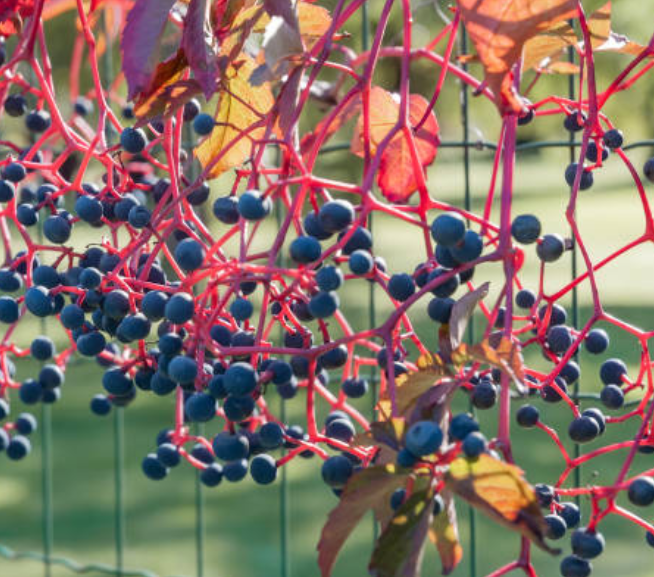
Virginia creeper is a woody, deciduous vine, usually with clusters of 5 leaves, that climbs up to 60’ on trees, poles or other structures. In some individuals, its sap will irritate the skin. Virginia creeper berries appear in autumn in clusters of ¼-inch bluish-black berries the size of BBs. They aren’t excessively toxic, but do contain microscopic oxalate crystals that may irritate delicate tissues in the mouth and cause vomiting in children.

Cotoneaster is a diverse species, usually found as a deciduous shrub or small tree. Originally from Europe and western Asia, it has naturalized throughout the northeast. Its bright orange berries grow in clusters in the fall, so thickly that the branches cannot be seen. Cotoneaster is mildly toxic to humans, and large amounts may cause trouble breathing, weakness, and seizures
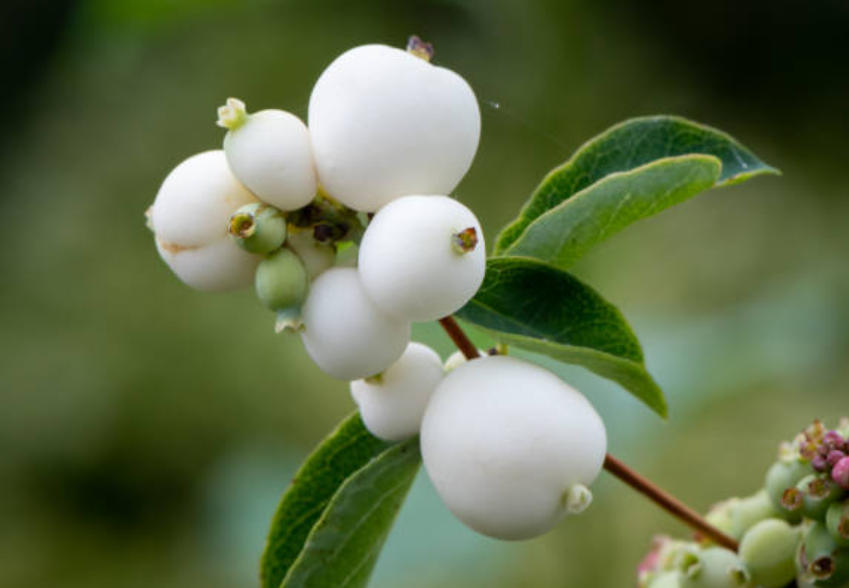
Common Snow Berry, also known as waxberry or white coralberry, is a shrub growing up to 9’ tall, most commonly found in open forests and clearings. It has oval leaves, and small pink or white bell-like flowers in dense clusters. In autumn, white berry-like drupes appear. These berries contain isoquinoline and large amounts of saponins, and ingesting them leads to vomiting, dizziness, and sedation in children.
Two other frequently foraged wild fruits that are not toxic in and of themselves, but do have characteristics to be aware of:
- Elderberries are deciduous shrubs that prefer damp, full-sun areas and produce small dark berries on umbrels in the late summer. The berries are delicious in pies, syrups, and jams, but they’re potentially toxic when raw, causing nausea, vomiting, and diarrhea.
- Chokecherry is a native, perennial, deciduous, woody, thicket-forming large erect shrub or small tree. It produces clusters of drooping dark red to black berries in mid to late summer. The flesh of the berries is safe to eat, but the seeds of the contain a toxin called glycoside and produce a compound similar to cyanide which is released during digestion. A single seed is not likely to cause serious symptoms but if enough are eaten symptoms can include dizziness, headaches, vomiting, increased heart rate and blood pressure, difficulty breathing, and kidney failure.

